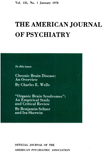GROUP THERAPY WITH PSYCHOTIC AND BORDERLINE MILITARY WIVES
Abstract
An effort has been made to present a useful structural and practical view of two open heterogeneous outpatient groups involving 29 psychotic and borderline military wives. Fourteen patients (48.3 percent) were diagnosed as schizophrenic; six (20.7 percent) were diagnosed psychotic depression; nine (31 percent) were diagnosed borderline, neurotic and character disorders. Typically, the patients had a history of psychiatric hospitalization and were frequent and well-known visitors to the medical and surgical outpatient clinics. In fact, they were the very disturbed and most unwanted patients who, in the absence of psychiatric treatment or its equivalent, are usually buffeted about clinics and psychiatric hospitals. The relatively closed military community was compelled to face the problem and develop some form of management. It did so through the psychiatric clinic. This paper describes the two outpatient groups which resulted. The following elements are discussed: 1) the rationale for treatment; 2) reasons for group therapy; 3) the patients; 4) the therapy contract; 5) the management of medications; 6) the vectors of interaction; 7) problems peculiar to the military; and 8) criteria for clinical and social-marital improvement and failure. The groups were distinctive because of the severity of illnesses represented, the involvement of husbands in the establishment of a rather firm treatment contract, the influence of the military environment and the individually oriented group therapy with associated drug therapy.
These 29 military wives were treated for varying lengths of time over a period of more than one and one-half years. The outcome of treatment was estimated separately for clinical and for social-marital change. Sixteen patients improved clinically; 17 improved socially; three became worse clinically; four became worse socially; ten were unchanged clinically; eight were unchanged socially. Eleven marriages experienced some turmoil, and eight husbands manifested symptoms or behavior associated with anxiety. Of the 15 patients in treatment more than six months, 13 improved, while of the 14 in treatment less than six months, only four improved, seven showed no change and three became worse. Almost all patients received tranquilizing medications before and during their period of treatment.
Access content
To read the fulltext, please use one of the options below to sign in or purchase access.- Personal login
- Institutional Login
- Sign in via OpenAthens
- Register for access
-
Please login/register if you wish to pair your device and check access availability.
Not a subscriber?
PsychiatryOnline subscription options offer access to the DSM-5 library, books, journals, CME, and patient resources. This all-in-one virtual library provides psychiatrists and mental health professionals with key resources for diagnosis, treatment, research, and professional development.
Need more help? PsychiatryOnline Customer Service may be reached by emailing [email protected] or by calling 800-368-5777 (in the U.S.) or 703-907-7322 (outside the U.S.).



